A Tribute to Daniel Ellsberg
TRANSCEND MEMBERS, 8 May 2023
Diane Perlman, Ph.D. | Substack - TRANSCEND Media Service
The Inspiration for My Psychological Study of Moral Heroism and the Courageous Personality
1 May 2023 – Daniel Ellsberg is the source of my inspiration to develop a theory of “the Courageous Personality.” His exceptional courage motivated me to study people who take great personal risks for truth, justice, peace, and freedom. I was curious about the psychology of the very few courageous souls who rise up in the face of oppression.
After the holocaust, a body of work on authoritarianism, conformity and obedience emerged as psychologists were grappling with understanding how this mass atrocity was able to happen and whether it could also happen in the US. In thinking about Dan’s example, I hypothesized that the courageous personality was the psychological opposite of the authoritarian personality.
Where would we be without our moral heroes? And, where would we be if there were many more? My intention was to shine a light on moral heroism to raise consciousness in the collective psyche to inspire more people to act. And, there is safety in numbers…
I wanted to honor Dan and express my love for him as he is struggling with pancreatic cancer. I am publishing the results of my study and my theory on the psychology of truth-tellers. It is a revised version of an earlier Substack. Here are the findings that resulted from my interviews with Dan and others: The Psychology of Truth-Tellers: Inspired by Dan Ellsberg.
1. Meeting Dan
I met Dan Ellsberg in June 1995, when he gave the keynote address at the International Psychohistorical Association (IPhA) annual conference in NYC, where I was giving a workshop (Eros Perverted: Analyzing Violence Through the Lens of Gender, which won IPhA’s scholarly achievement award).
Dan had recently called for and participated in a vigil and Fast for the Abolition of Nuclear Weapons, during the 1995 UN Nuclear Non-Proliferation Treaty (NPT) Review and Extension Conference.
We share an enduring commitment to addressing the nuclear threat. I have attended every NPT conference in NYC since 2000. I am motivated to continue to pursue this work even more vigorously in Dan’s honor by writing, speaking and representing civil society at the upcoming UN conferences on the Treaty on the Prohibition of Nuclear Weapons, (aka the Nuclear Ban Treaty), a Conference on a WMD Free Zone in the Middle East and the Nuclear Nonproliferation conferences. My contribution is always on overcoming barriers to nuclear disarmament. In addition to eliminating nuclear weapons, which are the symptoms, I bring in the need to reduce tensions and to address the underlying causes, conflicts, and relationships.

Dan wrote
“We are asking world political and religious leaders, outstanding figures in the arts and sciences, and concerned citizens in every country to participate, by fasting for one day, or more, wherever they are, in a worldwide Fast for the Abolition of Nuclear Weapons during the period of the Conference.
We invite you to join us in this Fast to bring a sense of moral urgency to the decisions being made in our name at the Conference. They will affect the future of humanity and the fate of the earth. (end block quote)
Daniel Ellsberg and Rev. William Sloane Coffin conducted a vigil and water fast at the Dag Hammarskjold Plaza outside the UN for the 26 days of the NPT Renewal Conference, April 17 to May 12, 1995.”
Dan gave a riveting talk at the Psychohistory conference about government deception, emphasizing military targeting of civilian populations in Germany and Japan during World War II. During the Q & A, I asked why, of all those who knew about the government lies surrounding the unwinnable Viet Nam War, was he the only one with the courage to risk exposing the truth. After he offered a philosophical answer, I said, “No, I mean what about your life, anything in your childhood, your personality?”
The Child is the Father to the Man[1]
Dan proceeded to open up to the large, already intrigued audience and told a very poignant story. As a child, Dan had been very close to his mother, who had great aspirations for him to become a concert pianist. It seems that in some way she needed him to live out an unfulfilled dream of her own. Perhaps her male child might be able to accomplish what females in society could not. Although he was required to practice for hours a day, he never felt that he was good enough, but he couldn’t say so. Thus, he was living with an internal contradiction, bound up with his mother’s love and devotion and fear of losing it if he was true to himself and quit.
When Dan was 14, the Ellsberg family went on a car trip to his mother’s family for a party for her. His father fell asleep at the wheel. The car hit a sidewall, killing Dan’s mother and his 11 months younger sister, Gloria, who had fought with him over her seat. (More details excerpted in APPENDIX 1)
In addition to the profound loss mixed with liberation from his involuntary destiny as a concert pianist, Dan pondered, “Why didn’t my father stop the car and take a nap? Why didn’t he ask my mother to drive? Was he too macho to admit to weakness?”
Dan grew up with a sense of avoidable tragedy and preoccupation with averting catastrophe, in addition to the importance of being true to oneself. During the Viet Nam War he may have wondered, “Is the government falling asleep at the wheel? Are they losing control of the car? “
Synchronistic Education: Intellectual and Spiritual Preparation for Hiroshima
On April 8, 2018, the day after Dan’s 87th birthday, Dan and Patricia Ellsberg were in DC for a book tour for The Doomsday Machine: Confessions of a Nuclear War Planner to raise consciousness about the dangers of US top secret, seventy-year-long nuclear policies.
At this poignant event, I learned of another significant formative event in Dan’s youth.
Dan descrbed how, in a stroke of fate, nine months before the US atomic bombing of Hiroshima and Nagasaki, August 6 and 9, 1945, he was blessed to have this amazing studies teacher, Bradley Patterson. See pages 1 – 4 in Building a Better Bomb: Reflections on the Atomic Bomb, the Hydrogen Bomb, and the Neutron Bomb
Patterson taught students how to think through the meaning and consequences of a new potential for mass killing in 1944. We owe a debt to this insightful teacher, who was ahead of his time. He was then teaching the deep, critical thinking that is so lacking in today’s education. This teacher got to witness how his teaching influenced history and [DS1] was a gift to humanity.
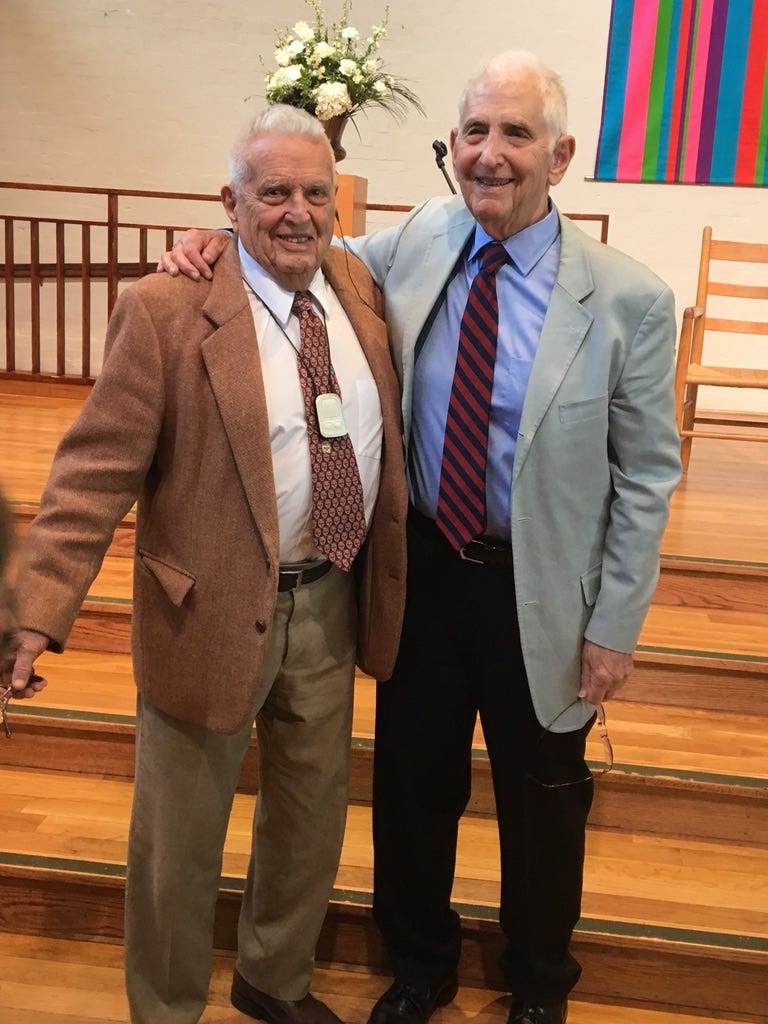
It was in a ninth-grade social studies class in the fall of 1944. I was 13, a boarding student on full scholarship at Cranbrook, a private school in Bloomfield Hills, Mich. Our teacher, Bradley Patterson, was discussing a concept that was familiar then in sociology, William F. Ogburn’s notion of “cultural lag.”
The idea was that the development technology regularly moved much further and
faster in human social-historical evolution than other aspects of culture: our institutions of government, our values, habits, our understanding of society and ourselves. Indeed, the very notion of “progress” referred mainly to technology. What lagged behind, what developed more slowly or not at all in social adaptation to new technology was everything that bore on our ability to control and direct technology and the use of technology to dominate other humans.To illustrate this, Mr. Patterson posed a potential advance in technology that might be realized soon. It was possible now, he told us, to conceive of a bomb made of U-235, an isotope of uranium, which would have an explosive power 1,000 times greater than the largest bombs being used in the war that was then going on. German scientists in late 1938 had discovered that uranium could be split by nuclear fission, in a way that would release immense amounts of energy.
….
Patterson had come across one of these wartime articles. He brought the potential development to us as an example of one more possible leap by science and technology ahead of our social institutions.
Suppose, then, that one nation, or several, chose to explore the possibility of making this into a bomb, and succeeded. What would be the probable implications of this for humanity? How would it be used, by humans and states as they were today? Would it be, on balance, bad or good for the world? Would it be a force for peace, for example, or for destruction? We were to write a short essay on this within a week.
…..
The existence of such a bomb—we each concluded—would be bad news for humanity. Mankind could not handle such a destructive force. It could not control it, safely, appropriately. The power would be “abused”: used dangerously and destructively, with terrible consequences. Many cities would be destroyed entirely, just as the Allies were doing their best to destroy German cities without atomic bombs at that very time, just as the Germans earlier had attempted to do to Rotterdam and London. Civilization, perhaps our species, would be in danger of destruction.
….
Moreover, reflecting on two related themes that have run through my life since then—intense abhorrence of nuclear weapons, and more generally of killing women and children—I’ve come to suspect that I’ve conflated in my emotional memory two events less than a year apart: Hiroshima and a catastrophe that visited my own family 11 months later.
Seeds of a Theory of the Courageous Personality
In later conversations, Dan and I mused about a personality pattern of those with high integrity who take risks for truth. Dan didn’t think there was a pattern, but in discussing it with other risk takers, they thought that maybe they were just a bit kooky (i.e., different but not in a derogatory way).
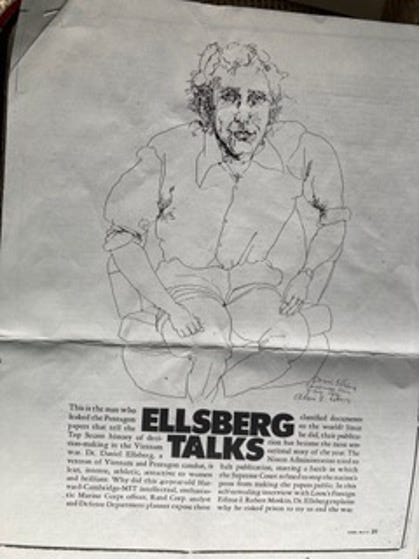
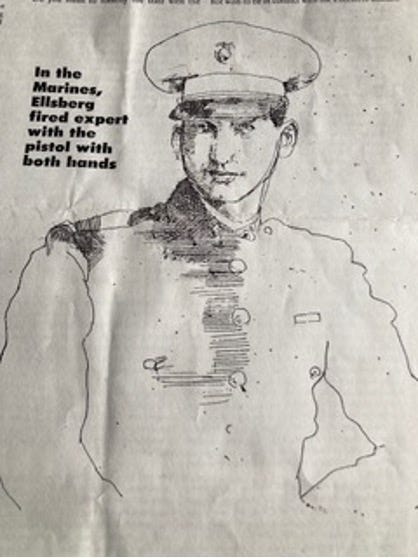
Then I came across a study of early parental loss and greatness, and another on how mothers of Presidents poured a lot of attention into them. These inspired some initial hypotheses about family of origin. I wondered about Dan’s mother’s deep devotion, the role of loss, the sense of failed enactment, values, and the relevance of personality types, such as intuition.
Dan also suggested other subjects for me to interview that ultimately led me to Gaza. He had recently attended the 1996 International Conference on Democracy, Disarmament and Human Rights: The Case of Mordechai Vanunu put on in Tel-Aviv by friends of Mordechai Vanunu, an Israeli whistleblower who had exposed Israel’s secret nuclear weapons program in Dimona, Israel. Vanunu, Dan’s Israeli counterpart, sadly fared far worse than Dan. Vanunu was entrapped, imprisoned and spent many years in solitary confinement. He was demonized and severely punished, as Israelis believed they would not exist without their nuclear program.
Dan gave me names of friends of Vanunu, including Israeli and Palestinian early peace pioneers. They were considered heretics before there was a formal peace process. They included Gidon Spiro, Akiva Orr and Eyad El- Saraj, founder of the wonderful Gaza Community Mental Health Programme (GCMHP). When I interviewed Eyad in Philadelphia, he invited me to present at GCMHP’s International Conference on Health and Human Rights in 1997 and 1999, where I met many others. GCMHP is a premier mental health program, and Eyad did very important work on trauma in children, and founded a Masters program on health and human rights. I was privileged to be at the first graduation.
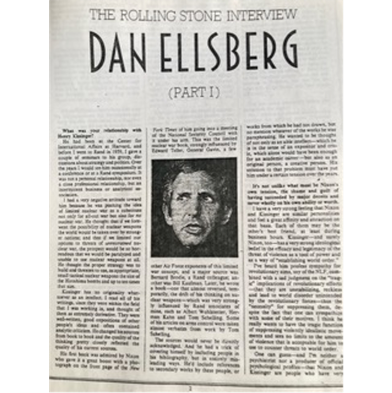
Above All, A Love Story
I love Dan, and Patricia too. Although Dan’s is a story of courage, it is above all a story of love. Love is inseparable from courage, whose root is the French word “cœur”, meaning heart. Since Dan announced his pancreatic cancer diagnosis, there has been an outpouring of love from friends and a grateful public.
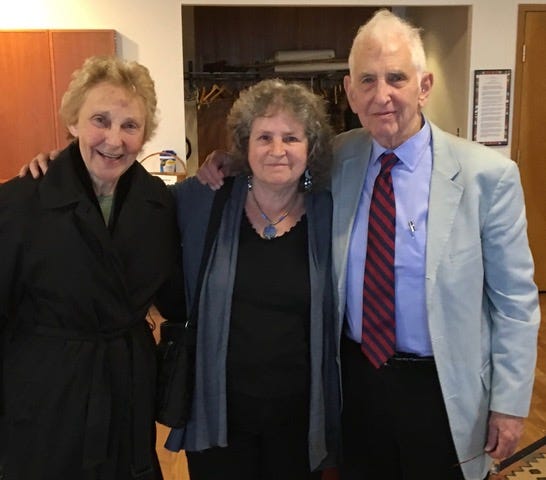
So many people have felt Dan’s love. Many whistleblowers from around the world reported being surprised to receive a call from Dan, offering support and mentoring.
In The Whistleblowers: A Webinar Honoring Daniel Ellsberg, on April 26, former CIA counterterrorism officer-turned-whistleblower John Kiriakou, described how Dan frequently wrote to him in prison, signing his letters, “Love, Dan.” Whistleblower attorney, Jesselyn Radack, was surprised to receive a call from Dan when she was subjected to government retaliation for doing her job. Dan was her hero, and she had written a paper about him. Many felt touched by Dan’s love and inspired by his courage.
As much as we are eternally grateful to Dan, many are not aware of our debt to his wife Patricia Marx Ellsberg, the perfect life partner. I connected with Patricia separately, over a year after I met Dan, at the inaugural event for the Society for the Universal Human in Oregon in 1996. Patricia herself is a fountain of love.
Patricia is not the woman behind the man–she is the woman beside the man. She is a teacher, lay Buddhist, spiritual leader, social change activist and speaker in her own right. She calls her work “Opening to the Divine Eros.”
To give you a sense of Patricia, here she is describing her experiential workshop in 2017 opening to the creative energy of the universe (15 minutes).
When Dan and Patricia first dated, she took him to a rally against the Vietnam War, and introduced him to the anti-war movement. They broke up over differences about war and peace. She turned down his first marriage proposal. Thankfully they got back together and she supported him through exposing the Pentagon papers and the trial. Happily for them, Dan was spared imprisonment and they were able to share a loving life together. Their love story is described in the documentary, The Most Dangerous Man in America.
It is easy to recognize Patricia’s role as Dan’s soul mate in supporting his contributions to humanity. Dan embodies all of the forms of love: Eros and romantic love, filial love for his friends, and agape, love for humanity. Some may tell you he also has no shortage of self-love, which no doubt enabled him to remained centered and confident enough to withstand the powerful forces arrayed against him.
I imagine that Dan can feel the love that he has given coming back to him now, as always.
Recognizing the historic value of Dan’s papers, UMass Amherst has agreed to create the Ellsberg Initiative for Peace and Democracy. Your gift in appreciation of a lifetime of service would help support the Initiative.
____________________________________-
Acknowledgement and much gratitude to David Schonbrunn for help with editing, clarity and being a sounding board.
I have a file of papers Dan gave me when I interviewed him around 1997. I photographed the first page of a few that you might find interesting (Go to Original).
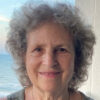 Diane Perlman, PhD is a clinical and political psychologist, devoted to applying knowledge from psychology, conflict studies and social sciences to designing strategies and policies to reverse nuclear proliferation, to drastically reduce terrorism, reduce enmity, and to raise consciousness about nonviolent strategies for tension reduction and conflict transformation. She is a visiting scholar at the School for Conflict Analysis and Resolution at George Mason University, is active in Psychologists for Social Responsibility, the TRANSCEND Network for Peace Development Environment, and on the Global Council of Abolition 2000. Some of her writings can be found on her websites, www.consciouspolitics.org and www.SanityandSurvival.com. Email: dianeperlman@gmail.com
Diane Perlman, PhD is a clinical and political psychologist, devoted to applying knowledge from psychology, conflict studies and social sciences to designing strategies and policies to reverse nuclear proliferation, to drastically reduce terrorism, reduce enmity, and to raise consciousness about nonviolent strategies for tension reduction and conflict transformation. She is a visiting scholar at the School for Conflict Analysis and Resolution at George Mason University, is active in Psychologists for Social Responsibility, the TRANSCEND Network for Peace Development Environment, and on the Global Council of Abolition 2000. Some of her writings can be found on her websites, www.consciouspolitics.org and www.SanityandSurvival.com. Email: dianeperlman@gmail.com
Go to Original – coronawise.substack.com
Tags: Daniel Ellsberg, Exposé, Investigative Journalism, Journalistic Ethics, Pentagon Papers, Vietnam War, Whistleblowing
DISCLAIMER: The statements, views and opinions expressed in pieces republished here are solely those of the authors and do not necessarily represent those of TMS. In accordance with title 17 U.S.C. section 107, this material is distributed without profit to those who have expressed a prior interest in receiving the included information for research and educational purposes. TMS has no affiliation whatsoever with the originator of this article nor is TMS endorsed or sponsored by the originator. “GO TO ORIGINAL” links are provided as a convenience to our readers and allow for verification of authenticity. However, as originating pages are often updated by their originating host sites, the versions posted may not match the versions our readers view when clicking the “GO TO ORIGINAL” links. This site contains copyrighted material the use of which has not always been specifically authorized by the copyright owner. We are making such material available in our efforts to advance understanding of environmental, political, human rights, economic, democracy, scientific, and social justice issues, etc. We believe this constitutes a ‘fair use’ of any such copyrighted material as provided for in section 107 of the US Copyright Law. In accordance with Title 17 U.S.C. Section 107, the material on this site is distributed without profit to those who have expressed a prior interest in receiving the included information for research and educational purposes. For more information go to: http://www.law.cornell.edu/uscode/17/107.shtml. If you wish to use copyrighted material from this site for purposes of your own that go beyond ‘fair use’, you must obtain permission from the copyright owner.
Thank you Diane! Very moving and inspiring!!